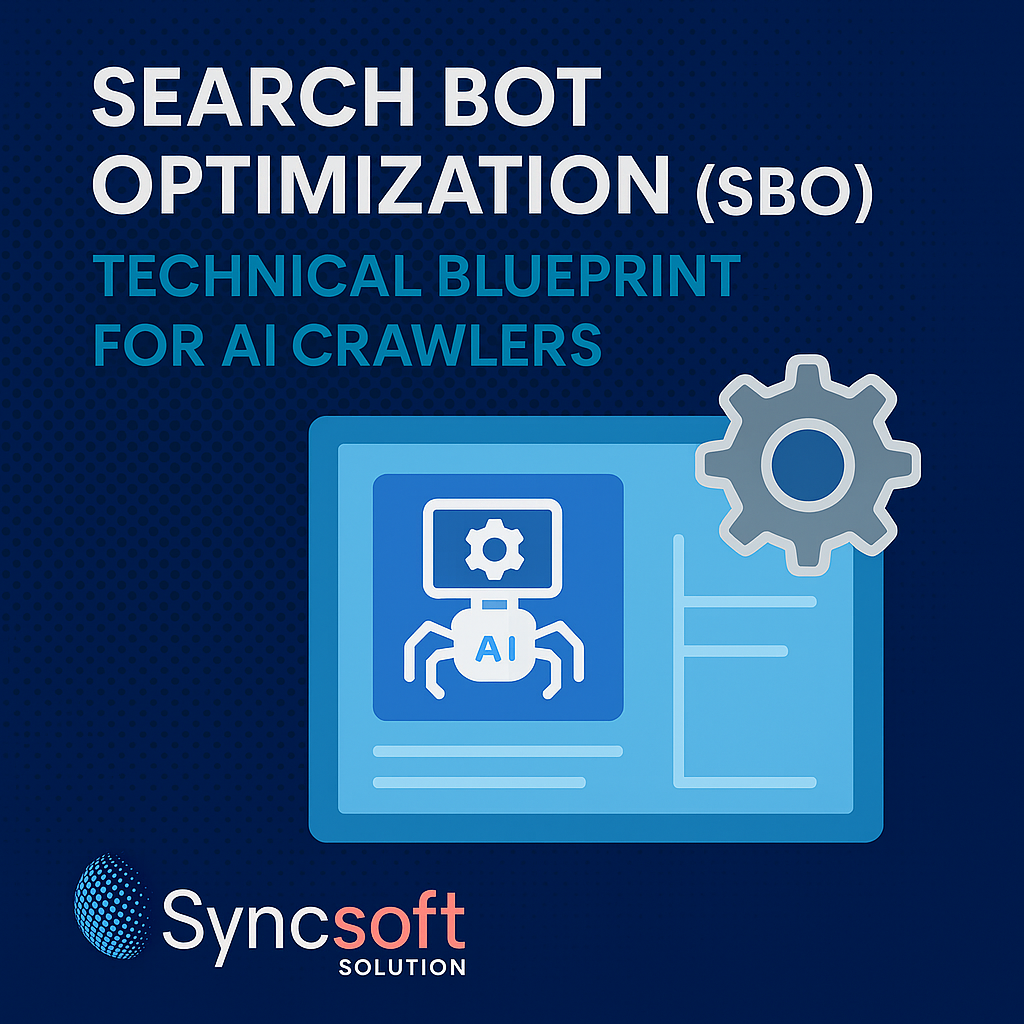AI-driven bots like Google Duplex, BingBot-AI, GPTBot, and PerplexityBot aren’t just scraping content anymore—they parse structured data, API responses, DOM trees, and load behavior to evaluate your site’s reliability. Traditional SEO focused on humans and HTML. SBO—Search Bot Optimization—is about engineering your site for AI crawlers that fuel both traditional SERPs and conversational agents.
This article outlines Sync Soft Solution technical playbook for making your site bot-friendly, schema-rich, and index-eligible in modern AI search ecosystems. We cover everything from robots.txt allowlist and edge delivery to RESTful APIs, structured data, and ethical bot behavior protocols.
1. Bot Accessibility—Beyond Robots.txt
1.1 Allowlist Major AI Bots
Modern AI bots include:
- GPTBot (OpenAI)
- ClaudeBot (Anthropic)
- Google-Extended
- PerplexityBot
- CCBot (Common Crawl)
Update your robots.txt:
User-agent: GPTBot
Allow: /
User-agent: Google-Extended
Allow: /Avoid universal disallows unless protecting sensitive areas.

1.2 Crawl Budget & Throttling
Use Crawl-delay only for known legacy bots. For AI crawlers:
- Serve compressed, server-rendered HTML
- Defer non-essential scripts for faster parse time
- Set conditional headers for partial content (HTTP 206)
1.3 Serving Data for Chunkers
AI crawlers like GPTBot split data into 8-32kB chunks. Serve HTML via pagination, and break long lists into sections. Provide <link rel="next"> and <section> wrappers for easier segmentation.
2. Semantic HTML & Schema Mastery
2.1 Semantic Layout
Use HTML5 landmarks:
<header>
<nav>
<main>
<article>
<aside>
<footer>These improve parse context.
2.2 Schema Types for SBO
Implement layered JSON-LD with:
WebPageOrganizationBreadcrumbListFAQPageProductorServiceOfferfor pricing
For AI sources:
DatasetCreativeWorkSoftwareSourceCode
2.3 Microdata & RDFa Fallbacks
Some bots support microdata. Provide fallback via HTML attributes for critical schema types.
<div itemscope itemtype="https://schema.org/Service">
<span itemprop="name">SEO Services</span>
</div>3. High-Performance Delivery
3.1 CDN & Edge Serving
- Use Cloudflare, Akamai, or Fastly edge servers
- Implement Edge-Side Includes (ESI) to dynamically inject content blocks
3.2 Compression & Preload
- Enable Brotli 11 for HTML/CSS/JS
- Preload hero image and LCP asset via:
<link rel="preload" as="image" href="hero.avif" type="image/avif">3.3 Image & Font Optimization
- Use AVIF/WebP for images
- Host critical fonts locally with preload directive
- Defer icon libraries and third-party assets
4. Structured APIs for AI Indexers
4.1 Public API Design
Expose public endpoints:
GET /api/articles?format=jsonldReturn structured responses with metadata:
{
"@context": "https://schema.org",
"@type": "Article",
"headline": "SEO Playbook 2025",
"author": {
"@type": "Person",
"name": "Deepak Verma"
},
"datePublished": "2025-06-10"
}4.2 CORS & Headers
Allow CORS headers:
Access-Control-Allow-Origin: *
Access-Control-Allow-Methods: GET4.3 API Documentation
Host your OpenAPI spec under /docs or /swagger.json for AI developer agents.
5. Bot Monitoring & Error Tracking
5.1 Log & Crawl Analysis
Pipe server logs into BigQuery or ELK. Extract:
- User-agent
- URL
- Status code
- Response time
- Referrer
Use regex filters to isolate GPTBot, BingBot, and Googlebot.
5.2 Alert Triggers
Trigger webhook alerts if:
- 5xx errors exceed 2% of bot requests
- 404s for critical schema URLs
- API latency > 300ms
5.3 Crawl-to-Index Ratio
Export crawl stats and correlate with Search Console indexation. Track URL-to-snippet conversion over time.
6. Ethical Guardrails & Security
6.1 Bot Identification
- Verify user-agent via DNS reverse lookup
- Set separate bot user permissions
- Serve identifiable metadata via
meta name="generator"
6.2 CAPTCHA & Access Controls
- Add reCAPTCHA on POST forms
- Use HTTP auth for staging/dev environments
- Block suspicious bots (semalt, crawler4j) via firewall rules
6.3 Transparency
Publish a /ai-policy page detailing how your content may be used by AI bots and what licensing applies.
7. Future-Proofing
SBO is evolving with each update of ChatGPT, Google Gemini, and Claude. Future-proof your setup by:
- Maintaining schema types
Dataset,Code,HowTo - Exposing clean data for agents like Perplexity and Glean
- Keeping page experience fast on mobile
Final Thought |Search Bot Optimization (SBO)
SBO is the technical foundation of discoverability in the AI-first web. From server logs to schema markup, every line of code influences how bots ingest and rank your content. At Sync Soft Solution, we help brands engineer crawl-ready, AI-indexable websites that win both classic rankings and snapshot features.
Implement this blueprint or book a technical audit with our engineers to elevate your site’s performance for AI search.
